1、 What is USBUSB: Universal Serial Bus, abbreviated as USB. Q, also known as Universal Serial Bus, is a standard for serial port buses and a technical specification for input-output interfaces. It is commonly used in 3 ℃ digital products, computers, mobile phones, printers, game consoles, etc., and is known as a universal interface. Currently, it has developed into an industry standard.
The following can all be called USB, which has various forms and can be further divided into USB-A, USB-B, USB-C, etc. based on their physical forms. In addition, each physical form has different transmission protocols, such as USB 1. x, USB 2.0, USB 3. x, etc. The main difference is the transmission speed.
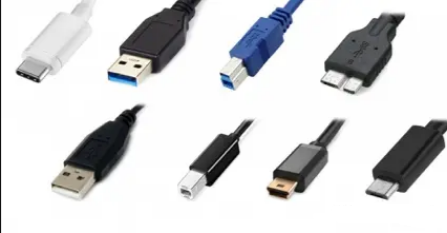
2、 The Evolution of USB Standards USBThe organization responsible for formulating transmission protocols is USB-IF, with members including Apple, Microsoft, HP, Intel, and others. From the first generation USB 1.0 in 1996 to the latest USB4, there have been many versions and name changes. There are probably many friends who don't know their differences, so let's follow me and take a look together~
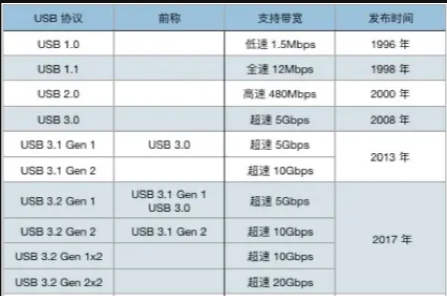
The Development of USB Protocol
1. USB 1.0In 1996, the first generation USB 1.0 was officially released with a transmission speed of only 1.5Mbps. The biggest feature is support for hot swapping, plug and play. Nowadays, USB 1.0 has become history.
2. USB 2.0In 2000, USB 2.0 was released, increasing the maximum transmission speed to 480Mbps. At that time, the transfer speed was very fast, but today any portable hard drive is T-level, and a 2k 4k movie is also G-level. USB 2.0 transfer speed is no longer sufficient
3. USB 3.0In 2008, USB30 was released, increasing the transmission speed to 5Gbps.
4. USB 3.1In 2013, USB 3.1 was released with a transmission speed of 10Gbps. Starting from here, USB-IF began its magical operation by renaming the previous interface standards, resulting in confusion in the current interface names.
The previous USB 3.0 was renamed USB 3.1 Gen 1, also known as the first generation USB 3.1, and the newly released USB 3.1 was renamed USB 3.1 Gen 2, also known as the second generation USB 3.1. The USB 3.0 mentioned earlier has disappeared into history.
5. USB 3.2
In 2017, USB 3.2 was released with a maximum speed of 20Gbps. No mistake, the USB-IF organization has renamed the interface standard again
The first generation USB 3.1 was renamed USB 3.2 Gen 1, also known as the first generation USB 3.2, and the second generation USB 3.1 was renamed USB 3.2 Gen 2, also known as the second generation USB 3.2. In this way, USB 3.1 also disappeared from the long river of history.
The newly released USB 3.2 (with a transmission speed of 20Gbps) is called USB 3.2 Gen 2x2, also known as dual channel second-generation USB 3.2
6. USB4
In 2019, USB4 was released in two versions, one at 20Gbps and the other at 40Gbps. Unified use of USB Type-C interface for physical interface form.
At this point, we have finally finished talking about the USB protocol. In order to ensure device compatibility, all protocols are backward compatible. Theoretical transmission speed comparison of various USB protocols:
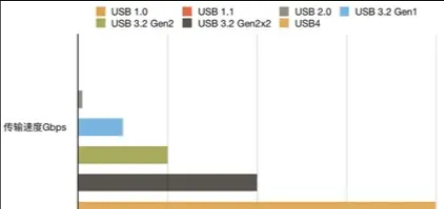
3、 Identification of USB interface
The USB 2.0, USB 3.1, USB 3.2, and USB4 mentioned earlier all refer to transmission standards that rely on physical interfaces to achieve functions such as data transmission and charging.
1. Interface type
At present, we commonly have the following types of interfaces:
USB Type-A
Also known as USB-A, it is very common in computer and mobile phone chargers. It is divided into male and female seats, and the common A-end of USB-A data cables is the male seat, while the charger is the female seat. To distinguish between different interface protocols, the USB-A interface color of the USB 3.0 protocol is usually blue.
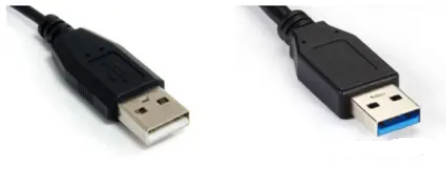
Left: Type-A for USB 2.0, Right: Type-A for USB 3.0
USB Type-B
Also known as USB-B, it is usually used on printer devices, with the other end connected to a computer using USB-A.
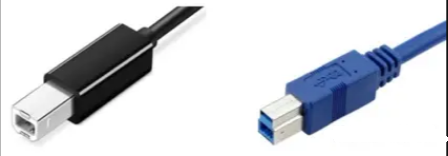
USB Type-C
Also known as USB-C, as a new generation universal interface, it integrates functions such as USB data, PD charging, audio and video display output, and is expected to become the unified interface in the market. It was proposed with the USB 3.1 (specifically referring to USB 3.1 Gen2, now known as USB 3.2 Gen2, the same below) standard.
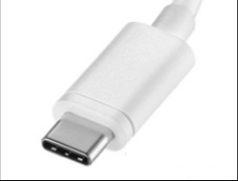
USB Type-C
I have to mention USB 3.1 here.
The USB 3.1 referred to here refers to USB 3.1 Gen2, while USB 3.1 Gen1 is just a renaming of USB 3.0 with no changes in functionality.
This is because USB-IF changed its name too hastily, resulting in confusion in naming now.
The coding standard has been upgraded from 8b/10b in USB 3.0 to 128b/132b, and the coding loss has been reduced from 20% to 3%.
The intuitive feeling is that the transmission speed loss has been reduced from 20% to 3%, which is equivalent to the original load of only 80%, now it has become a load of 97%.
Maximum support for 100W power output
The voltage is not limited to 5V, but also provides various other specifications, which means there are many more options for charging. USB Type - ℃ not only has the characteristics of USB 3.1, but also has:
1. No direction, supports forward and backward blind insertion
2. Supports Thunderbolt 3 transmission protocol, which will increase the transmission speed from 10Gbps on USB 31 to 40 Gbps
2. What is PD fast chargingThe full name is USB Power Delivery, abbreviated as USB PD, which is a charging standard and technology developed by the USB-IF organization. It was first released in 2012.
Starting from USB 2.0, a working group called Battery Charging (belonging to the USB-IF organization) began researching how to provide power to USB. Until the release of the BC v1.2 specification, it only supported a maximum of 7.5W charging. In the era of small capacity batteries for small devices, it could meet the charging requirements, but today it is no longer possible to meet them. Apple's unchanging "Five Blessings and One Safety", with only 5W of power, takes several hours to fully charge, which is really unbearable.
In order to address the issue of higher charging power, USB-IF has established another working group, Power Delivery. Then came the USB Power Delivery (PD) charging standard currently in use.
USB PD 1.0
In 2012, USB PD 1.0 was released, which can be charged with voltages of 5V, 12V, and 20V, with a maximum power of 100W. Supports the following power configurations:
10W:5V2A
18W:12V 1.5A
36W:12V 3A
60W:12V5A、20V 3A
100W:20V 5A
USB PD 2.0In 2014, USB PD 2.0 was released and replaced with the USB Type C interface using the USB 3.1 standard.
USB PD 3.0In 2015, USB PD 3.0 was released, which joined PPS (Programmable Power Supply) and is compatible with various fast charging protocols. The latest specification already supports Qualcomm QC4 fast charging protocol. This is impressive. The goal is to eliminate other fast charging protocols and prioritize myself.
USB PD 2.0 and USB PD 3.0 support the following power configurations, and the charging power is much larger than the 1.0 version.
Due to various reasons, USB PD 10 is not widely adopted in the market. In contrast, the newer USB 2.0 and USB PD 3.0 are more widely recognized and used in the market.
USB PD fast charging still has a long way to go to unify the market. The self-developed fast charging technology by domestic mobile phone manufacturers has become their respective promotional selling points, and it is feared that mobile phone manufacturers will not be able to give up their fast charging technology in the short term. In the long run, unified fast charging technology is beneficial for regulating the market, and consumers no longer have to worry about the charging issues of various devices.
3. Not all USB Type-C are versatileUSB Type - ℃ is just a physical interface form. Although it supports PD charging, USB data transfer, and DisplayPort display, in reality, it still depends on whether the device manufacturer has matched the corresponding functions. Device manufacturers are free to choose the features they want to support, and can also provide a fully functional USB-C interface. However, due to cost and other reasons, there may only be one or a few features available.
Some devices may use the USB Type-C interface, but they may not necessarily use the USB 3.1 interface protocol. (The USB3.1 referred to here refers to USB 3.1 Gen2, now known as USB 3.2 Gen 2, the same below)
So, don't think that USB Type-C is USB 3.1, and conversely, if an interface uses the USB 3.1 standard, then the physical interface form must be UsB Type-C.
When purchasing devices with USB-C interfaces, special attention should be paid to the functions supported by the interfaces. The computer below is specially marked with a fully functional USB Type-C interface.
4. USB Type-C is not a USB PD
USB PD is a charging standard and technology developed by the USB-IF organization, first released in 2012. USB power capacity can be increased to 100W. These two nouns cannot be interchanged. Additionally, the presence of a USB-C interface does not necessarily support the PD fast charging protocol.
5. Regarding the noun Type-C
According to the official information of USB-IF, there is no such name. The only officially recommended name is USB Type-C, also known as USB-C for short





